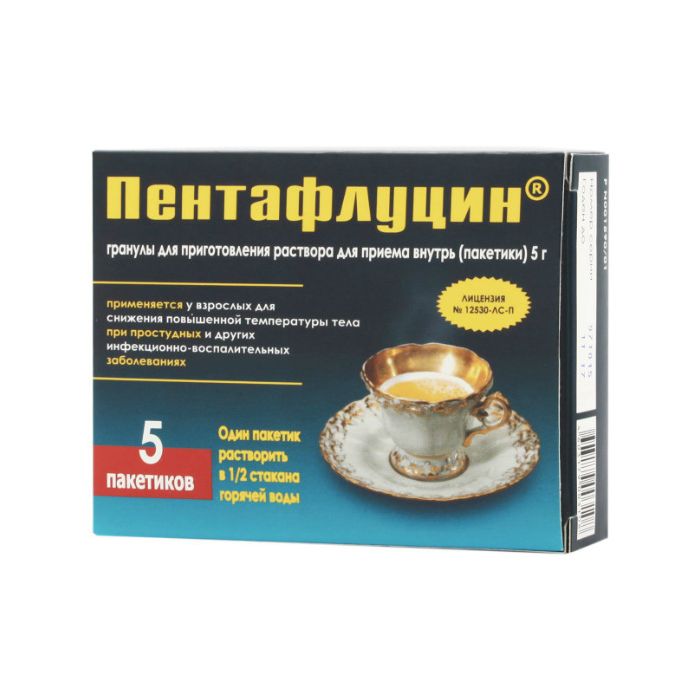Paracetamol, Ascorbic acid, Rutoside, Diphenhydramine, Calcium gluconate | Pentaflucin granules 5 g sachets 5 pcs.
Special Price
$15.68
Regular Price
$23.00
In stock
SKU
BID463174
Latin name
Pentaflucin
Pentaflucin
Latin name
Pentaflucin
Release form
Pentaflucin. Granules for oral solution.
Packaging
5 g - sachets (5) - packs of cardboard.
Pharmacological action
Combined drug with antipyretic and anti-inflammatory effects.
Paracetamol has an antipyretic and analgesic effect. Non-narcotic analgesic, blocks COX-1 and COX-2 mainly in the central nervous system, affecting the centers of pain and thermoregulation. In inflamed tissues, cellular peroxidases neutralize the effect of paracetamol on COX, which explains the almost complete absence of anti-inflammatory effect.
Ascorbic acid plays an important role in the regulation of redox processes, carbohydrate metabolism, blood coagulation, tissue regeneration, and increases the body's resistance.
Diphenhydramine has an antihistamine and anti-inflammatory, sedative and hypnotic effect.
Calcium gluconate is a regulator of calcium and phosphorus metabolism.
Rutoside reduces capillary permeability and fragility, has antioxidant properties.
Indications
Hyperthermia in colds and other infectious and inflammatory diseases.
Contraindications
hypersensitivity
renal and / or liver failure
blood disease with a tendency to hemorrhage
glucose-6-phosphate dehydrogenase deficiency
pregnancy
lactation.
Caution: Gilbert syndrome (constitutional hyperbilirubinemia), childhood (up to 16 years).
Use during pregnancy and lactation
Contraindications: pregnancy lactation.
Composition
1 sachet contains
Active ingredients:
paracetamol 500 mg,
ascorbic acid 200 mg,
diphenhydramine 20 mg,
rutin 20 mg.
Dosage and administration
Inside after a meal, 1 pack. 3-4 times a day for 3-5 days. Dissolve 1 packet of the drug in 1/2 cup of hot water (a slight precipitate in a glass is allowed). Apply freshly prepared solution.
Side effects
Skin allergic reactions, nausea, vomiting, headache, drowsiness, general weakness, dizziness.
Rarely - thrombocytopenia, leukopenia, agranulocytosis.
With prolonged use in high doses, hepatotoxic and nephrotoxic effects are possible.
Drug Interaction
The combination of the drug with barbiturates, anticonvulsants, diphenin, carbamazepine, rifampicin should be avoided, zidovudine and other inducers of microsomal liver enzymes.
Overdose
Symptoms: nausea, vomiting, stomach ache, 1-2 days - liver failure, encephalopathy, coma.
Treatment: induce vomiting, wash stomach, appointment of adsorbents (activated carbon), symptomatic therapy (administration of methionine, acetylcysteine).
Storage conditions
Store in a dry, dark place, out of the reach of children.
Expiration
2 Year
Deystvuyuschee substances
Paracetamol, ascorbic acid, Rutozyd, Diphenhydramine, calcium gluconate
Dosage
dosage form
oral solution
Uralbiofarm, Russia
Pentaflucin
Release form
Pentaflucin. Granules for oral solution.
Packaging
5 g - sachets (5) - packs of cardboard.
Pharmacological action
Combined drug with antipyretic and anti-inflammatory effects.
Paracetamol has an antipyretic and analgesic effect. Non-narcotic analgesic, blocks COX-1 and COX-2 mainly in the central nervous system, affecting the centers of pain and thermoregulation. In inflamed tissues, cellular peroxidases neutralize the effect of paracetamol on COX, which explains the almost complete absence of anti-inflammatory effect.
Ascorbic acid plays an important role in the regulation of redox processes, carbohydrate metabolism, blood coagulation, tissue regeneration, and increases the body's resistance.
Diphenhydramine has an antihistamine and anti-inflammatory, sedative and hypnotic effect.
Calcium gluconate is a regulator of calcium and phosphorus metabolism.
Rutoside reduces capillary permeability and fragility, has antioxidant properties.
Indications
Hyperthermia in colds and other infectious and inflammatory diseases.
Contraindications
hypersensitivity
renal and / or liver failure
blood disease with a tendency to hemorrhage
glucose-6-phosphate dehydrogenase deficiency
pregnancy
lactation.
Caution: Gilbert syndrome (constitutional hyperbilirubinemia), childhood (up to 16 years).
Use during pregnancy and lactation
Contraindications: pregnancy lactation.
Composition
1 sachet contains
Active ingredients:
paracetamol 500 mg,
ascorbic acid 200 mg,
diphenhydramine 20 mg,
rutin 20 mg.
Dosage and administration
Inside after a meal, 1 pack. 3-4 times a day for 3-5 days. Dissolve 1 packet of the drug in 1/2 cup of hot water (a slight precipitate in a glass is allowed). Apply freshly prepared solution.
Side effects
Skin allergic reactions, nausea, vomiting, headache, drowsiness, general weakness, dizziness.
Rarely - thrombocytopenia, leukopenia, agranulocytosis.
With prolonged use in high doses, hepatotoxic and nephrotoxic effects are possible.
Drug Interaction
The combination of the drug with barbiturates, anticonvulsants, diphenin, carbamazepine, rifampicin should be avoided, zidovudine and other inducers of microsomal liver enzymes.
Overdose
Symptoms: nausea, vomiting, stomach ache, 1-2 days - liver failure, encephalopathy, coma.
Treatment: induce vomiting, wash stomach, appointment of adsorbents (activated carbon), symptomatic therapy (administration of methionine, acetylcysteine).
Storage conditions
Store in a dry, dark place, out of the reach of children.
Expiration
2 Year
Deystvuyuschee substances
Paracetamol, ascorbic acid, Rutozyd, Diphenhydramine, calcium gluconate
Dosage
dosage form
oral solution
Uralbiofarm, Russia
Write Your Own Review

